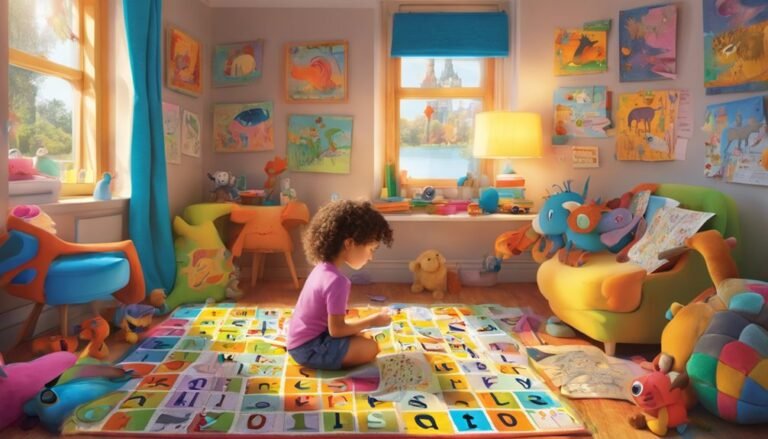Reading to Your Infant: Tips and Tricks
Have you ever wondered if reading to your infant can really make a difference in their development? Well, the answer might surprise you. Research has shown that exposing babies to language through books at an early age can have a profound impact on their language skills and cognitive development.
But how exactly should you go about introducing books to your little one? In this discussion, we will explore some tips and tricks that will help you create a positive and engaging reading experience for your infant, fostering a love for learning and setting the foundation for their future academic success.
So, let’s dive in and discover the secrets to nurturing your baby’s growing mind!
Key Takeaways
- Reading to your infant enhances language development and sets the foundation for future language skills.
- Choosing the right books for your baby involves considering their age and developmental stage, as well as selecting books with bright colors, simple text, and familiar objects or animals.
- Creating a cozy reading environment involves choosing a quiet and well-lit area away from distractions and noise, using soft lighting and maintaining a comfortable temperature, and arranging pillows and cushions for support and comfort.
- Engaging your baby during storytime can be done by using interactive books, incorporating sensory play with props or materials related to the story, using expressive gestures and sounds to bring the story to life, and making storytime a multi-sensory experience.
The Benefits of Reading to Your Infant
Reading to your infant has numerous benefits that can greatly impact their cognitive development. Not only does it enhance language development, but it also strengthens the bond between you and your baby. When you read aloud to your little one, you’re exposing them to a rich vocabulary and a variety of sounds, which helps them learn new words and understand the patterns of language. This early exposure to language sets the foundation for their future language skills.
As you cuddle up with your baby and read together, you create a special moment of intimacy and connection. The soothing sound of your voice, the gentle touch, and the shared experience of exploring books together all contribute to a deepening bond between you and your little one. This bonding time isn’t only enjoyable for both of you, but it also promotes a sense of security and trust in your relationship.
Furthermore, reading to your infant stimulates their imagination and creativity. The colorful pictures and engaging stories in children’s books capture their attention and spark their curiosity. Through these stories, your baby begins to develop their own narrative skills, which are crucial for later reading comprehension and critical thinking.
Choosing the Right Books for Your Baby
When choosing books for your baby, it’s important to consider their age and developmental stage to ensure they’re both entertained and stimulated.
Interactive books and sensory board books are two great options to keep in mind.
Interactive books engage your baby’s senses and encourage them to participate in the reading experience. These books often have flaps to lift, textures to feel, or buttons to press, making reading a fun and interactive activity for your little one.
Sensory board books, on the other hand, are specifically designed to stimulate your baby’s senses. They feature different textures, colors, and shapes that your baby can explore through touch and sight. These books aren’t only entertaining but also help in developing your baby’s sensory skills.
When choosing books, make sure to select ones with bright and contrasting colors, simple and repetitive text, and familiar objects or animals. These elements will capture your baby’s attention and make the reading experience enjoyable for both of you.
Creating a Cozy Reading Environment
To create a cozy reading environment for your baby, focus on creating a comfortable and inviting space where you can both enjoy the magic of books together. Setting the mood is essential for a pleasant reading experience. Choose a quiet and well-lit area in your home, away from distractions and noise. Soft lighting, such as a lamp with a warm glow, can create a soothing atmosphere. Make sure the temperature is just right – not too hot or too cold – to keep your little one comfortable.
Creating a reading nook can add to the coziness. Use a soft, padded mat or rug to create a designated space for reading. Arrange pillows and cushions for you and your baby to sit on, providing support and comfort. Consider using a small bookshelf to store your baby’s books within reach, making it easy for you to pick out stories together.
Don’t forget about the power of touch. Surround your reading nook with soft and tactile materials, like plush toys or blankets. These can add a sensory element to your reading sessions, enhancing your baby’s engagement and enjoyment.
Engaging Your Baby During Storytime
Make storytime interactive by incorporating simple gestures, sounds, and facial expressions to captivate your baby’s attention and enhance their understanding. Engaging your baby during storytime not only makes it more enjoyable for both of you, but it also helps develop their cognitive and language skills.
Here are three ways you can make storytime a sensory experience for your little one:
-
Use Interactive Books: Choose books with flaps to lift, textures to touch, or sound buttons to press. These interactive elements will keep your baby engaged and actively participating in the story. As you read, encourage them to explore the book by pointing out different pictures or asking them to find specific objects.
-
Incorporate Sensory Play: Create a multi-sensory experience by involving different senses during storytime. For example, you can use props or toys that relate to the story, such as a stuffed animal for a story about animals. You can also incorporate sensory materials like fabric or feathers for your baby to touch and feel while you read.
-
Use Expressive Gestures and Sounds: Bring the story to life by using expressive gestures and sounds. Use your hands to act out the actions in the story or make animal noises. Your baby will be captivated by your animated storytelling and will be more engaged in the narrative.
Incorporating Different Reading Techniques
To further enhance your baby’s learning experience during storytime, try incorporating different reading techniques that can stimulate their curiosity and imagination. Interactive reading is a great way to keep your little one engaged and involved in the story. Instead of simply reading the words on the page, you can ask questions, make funny voices for different characters, or even encourage your baby to touch and feel the pictures in the book. This not only helps develop their cognitive skills but also fosters a love for reading.
Another technique to consider is using sensory books. These books are specially designed to appeal to your baby’s senses, such as touch, sight, and sound. They often have different textures for your baby to explore, flaps to lift, or buttons to press that make sounds. Sensory books not only make storytime more interactive but also provide a multi-sensory experience that can help with your baby’s sensory development.
Here is a table to summarize the different reading techniques you can try:
| Technique | Description |
|---|---|
| Interactive Reading | Engage your baby by asking questions, using different voices, and encouraging touch and feel. |
| Sensory Books | Books that appeal to your baby’s senses, such as touch, sight, and sound, for a multi-sensory experience. |
Incorporating these different reading techniques into your storytime routine can make it a fun and enriching experience for both you and your baby. So grab a book, get cozy, and let the reading adventure begin!
Making Reading a Daily Ritual
Establishing a daily reading routine with your infant is a simple yet powerful way to nurture their love for books and language. By incorporating reading into their daily lives, you can create a special bond with your little one while also developing their language skills.
Here are three tips to help you make reading a daily ritual:
-
Set a consistent time: Establishing a bedtime routine that includes reading can signal to your baby that it’s time to wind down and prepare for sleep. Make it a part of their nightly routine, so they anticipate storytime before bed.
-
Create a cozy environment: Find a comfortable spot where you and your baby can snuggle up together with a few favorite books. Dim the lights, play some soft music, and create a peaceful atmosphere that will encourage relaxation and enjoyment.
-
Be interactive: As you read, engage your baby by using different voices, facial expressions, and gestures. Encourage them to touch and explore the pictures in the book. This interaction not only deepens their understanding but also makes reading a fun and interactive experience.
Troubleshooting Common Challenges
If you find yourself facing common challenges while reading to your infant, don’t worry, there are simple solutions to help you overcome them.
Dealing with distractions and maintaining your baby’s attention can be tricky, but with a few techniques, you can create a successful reading experience for both of you.
First, let’s tackle distractions. Babies are naturally curious and easily get distracted by their surroundings. To minimize this, find a quiet and comfortable space where you can read together. Dim the lights and eliminate any potential distractions like toys or electronics. Creating a calm environment will help your baby focus on the story.
Next, let’s discuss maintaining your baby’s attention. Infants have short attention spans, so keep the reading sessions short and engaging. Choose books with colorful illustrations and simple, repetitive text. Use different voices and facial expressions to make the story come alive. Incorporate interactive elements like touch-and-feel or lift-the-flap books to keep your baby engaged.
Frequently Asked Questions
How Can I Encourage My Infant to Show Interest in Books?
To encourage your infant’s interest in books, start by making reading time a special bonding experience. Use engaging voices, point out pictures, and let them explore the book. This helps develop early literacy skills and sparks curiosity.
What Are Some Age-Appropriate Books for Newborns?
Looking for age-appropriate books for your newborn? Check out popular board books that are perfect for little ones, like "Goodnight Moon" and "Pat the Bunny." These books are great for developing visual and tactile skills.
Should I Read to My Baby Even if They Can’t Understand the Words Yet?
Yes, reading to your baby is beneficial even if they can’t understand the words yet. It helps with language development and creates a special bonding experience. Make reading time cozy, use funny voices, and cuddle up together.
How Can I Make Storytime More Interactive for My Infant?
To make storytime engaging for your little one, try creating a sensory experience. Use colorful books with textures, make funny voices and sound effects, and encourage them to touch and explore the pages.
Are There Any Specific Reading Techniques That Can Help Stimulate My Baby’s Brain Development?
To stimulate your baby’s brain development, try incorporating specific reading techniques into storytime. By using interactive books, varying your tone, and engaging with your baby, you can create a rich and stimulating reading experience.
Conclusion
In conclusion, reading to your infant is a magical journey that opens a world of possibilities.
Like a gentle breeze guiding a sailboat, books have the power to stimulate your baby’s imagination and language development.
By choosing the right books, creating a cozy reading environment, and engaging your baby during storytime, you’re laying the foundation for a lifelong love of reading.
So, set sail on this literary adventure with your little one and watch their curiosity and joy soar.
Happy reading!








